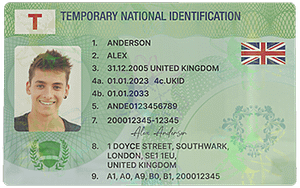Fake ID card rings have long been a persistent and concerning issue in society. These illegal operations are not just about providing false identification to under – aged individuals looking to access restricted areas like bars or clubs. They also pose serious threats to national security, financial systems, and public safety. Law enforcement agencies around the world are constantly evolving their strategies to combat these fake ID card rings effectively.
Understanding Fake ID Card Rings
Fake ID card rings are organized criminal networks that specialize in the production, distribution, and sale of counterfeit identification documents. These documents can include driver’s licenses, passports, social security cards, and other forms of official identification. The rings often use sophisticated equipment and techniques to make the fake IDs look as authentic as possible. They may have access to high – quality printers, scanners, and software that can replicate security features such as holograms, watermarks, and microprinting.

Their clientele is diverse. While some are young people trying to bypass age – related restrictions, others include illegal immigrants seeking to establish false identities, criminals looking to avoid detection, and fraudsters aiming to commit financial crimes. The impact of these fake ID card rings is far – reaching, causing harm to individuals, businesses, and governments alike.
Law Enforcement Strategies for Cracking Down
Intelligence – Gathering
One of the first steps in combating fake ID card rings is intelligence – gathering. Law enforcement agencies work with informants, conduct undercover operations, and analyze data from various sources. For example, they may monitor online forums and marketplaces where fake IDs are often advertised for sale. By infiltrating these virtual spaces, they can identify key players in the rings, including the manufacturers, distributors, and sellers. Additionally, they collaborate with other agencies, both domestic and international, to share information and stay updated on the latest trends and techniques used by the criminals.
Investigative Techniques
Once intelligence has been gathered, law enforcement agencies employ a range of investigative techniques. Forensic analysis is crucial in examining fake ID cards. Experts use specialized equipment to study the materials, printing methods, and security features of the counterfeit documents. This analysis can help trace the origin of the fake IDs, such as the type of printer used or the source of the materials. Surveillance is another important tool. Law enforcement officers may follow suspects to identify their meeting places, production facilities, and distribution routes. This can lead to the discovery of large – scale manufacturing operations and the arrest of multiple members of the ring.
Collaboration and Task Forces
Law enforcement agencies often form task forces to specifically target fake ID card rings. These task forces bring together officers from different departments, such as the police, customs, and immigration. By pooling their resources and expertise, they can conduct more comprehensive investigations. For example, customs officers may intercept shipments of fake ID – related materials at the border, while police officers are responsible for raiding production facilities on the ground. International collaboration is also essential, as many fake ID card rings operate across borders. Agencies work with their foreign counterparts to share intelligence, conduct joint operations, and extradite suspects.
Legal Measures
To effectively crack down on fake ID card rings, law enforcement also relies on strong legal measures. Governments have enacted strict laws against the production, sale, and use of fake ID cards. Penalties for those involved in these illegal activities can include hefty fines and significant prison sentences. Law enforcement agencies work closely with prosecutors to ensure that cases are built solidly and that the defendants are held accountable under the law. Additionally, they may seek to seize the assets of the criminals involved, including any profits made from the fake ID business and the equipment used in production.
Success Stories in Cracking Down on Fake ID Card Rings
In many countries, there have been notable successes in the fight against fake ID card rings. For instance, in the United States, a joint operation by the Secret Service and local law enforcement agencies led to the dismantling of a large – scale fake ID production network. The operation involved months of surveillance and intelligence – gathering. When the time was right, multiple raids were carried out simultaneously at different locations. The ring was found to be using state – of – the – art equipment to produce fake driver’s licenses and passports, which were being sold to a wide range of customers across the country. As a result of the operation, dozens of individuals were arrested, and a significant amount of fake ID – related materials and equipment were seized.
In Europe, a trans – national task force made up of officers from several countries was able to disrupt a fake ID ring that was supplying illegal immigrants with false passports. Through a combination of intelligence – sharing and coordinated raids, the task force was able to identify the key members of the ring, who were operating in different countries. The arrests and seizures not only stopped the flow of fake passports but also sent a strong message to other potential criminals in the region.
Challenges Faced by Law Enforcement
Technological Advancements
One of the biggest challenges for law enforcement is keeping up with the rapid technological advancements used by fake ID card rings. Criminals are constantly developing new methods to create more realistic – looking fake IDs. For example, 3D printing technology has made it easier to replicate complex shapes and textures, such as the raised text on a driver’s license. Law enforcement agencies need to invest in advanced forensic tools and training to be able to detect these sophisticated counterfeits. Additionally, as the digital age progresses, criminals are increasingly using online platforms to market and sell their fake IDs, making it more difficult to track them down.
Cross – Border Operations
Fake ID card rings often operate across multiple borders, which complicates law enforcement efforts. Different countries have different laws and regulations regarding fake IDs, and cooperation between nations can sometimes be slow or difficult. Language barriers, differences in legal systems, and varying levels of law enforcement capacity in different regions can all impede the effectiveness of cross – border operations. For example, a fake ID production facility in one country may be supplying customers in several others, and coordinating the necessary investigations and arrests across these borders can be a complex and time – consuming process.
Anonymity in the Digital World
The anonymity provided by the digital world is another major challenge. Criminals can use encrypted communication channels and virtual private networks (VPNs) to hide their identities and locations. Online marketplaces for fake IDs can be difficult to shut down, as they can quickly move to new domains or platforms. Law enforcement agencies need to develop new techniques and tools to penetrate this digital anonymity and identify the individuals behind the fake ID operations.
Common Problems and Solutions
- Problem: Difficulty in detecting sophisticated fake IDs
Solution: Law enforcement agencies should invest in advanced forensic technology, such as high – resolution scanners, chemical analysis tools for materials, and software that can detect anomalies in security features. Regular training for officers on the latest fake ID detection techniques is also essential. For example, training on how to identify fake holograms based on their color, texture, and alignment can significantly improve detection rates. - Problem: Lack of international cooperation in cross – border cases
Solution: Governments should establish more formal agreements and channels for international cooperation in combating fake ID card rings. This can include the sharing of intelligence databases, joint training programs for law enforcement officers from different countries, and streamlined extradition processes. For instance, creating a global task force dedicated to fake ID – related crimes with representatives from major countries can enhance cooperation. - Problem: Online marketplaces for fake IDs are hard to shut down
Solution: Law enforcement agencies should work closely with internet service providers (ISPs) and hosting companies to identify and block websites selling fake IDs. Additionally, they can use digital forensics to trace the operators of these websites and bring them to justice. Collaboration with social media platforms to remove any advertisements or listings related to fake IDs is also crucial. For example, setting up a reporting system on social media for users to flag fake ID – related content can help in early detection and removal. - Problem: Informants are reluctant to come forward
Solution: Law enforcement should establish safe and confidential channels for informants to provide information. Offering incentives such as reduced sentences for those involved in fake ID rings who turn informant, or financial rewards for valuable information, can encourage people to come forward. Additionally, ensuring the protection of informants’ identities through strict legal measures can increase their willingness to cooperate. - Problem: Lack of public awareness about the dangers of fake ID card rings
Solution: Law enforcement agencies, in collaboration with schools, community groups, and the media, should launch public awareness campaigns. These campaigns can educate the public about the risks associated with fake IDs, such as identity theft, financial fraud, and national security threats. For example, distributing brochures in schools and community centers, and running public service announcements on television and radio can help raise awareness.



